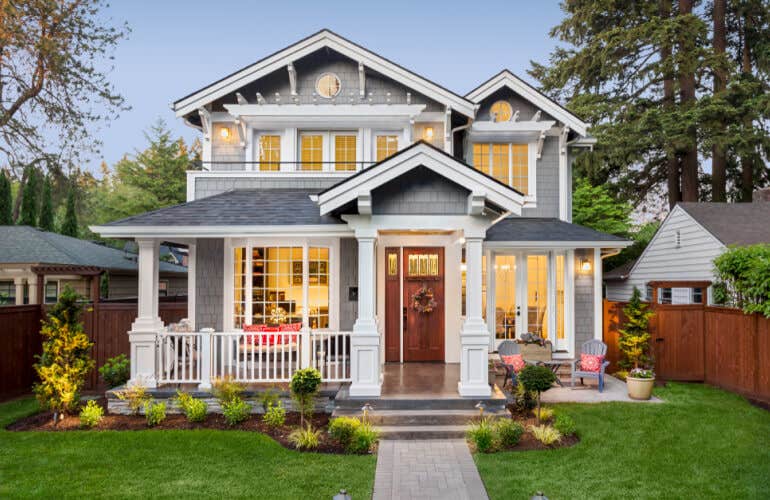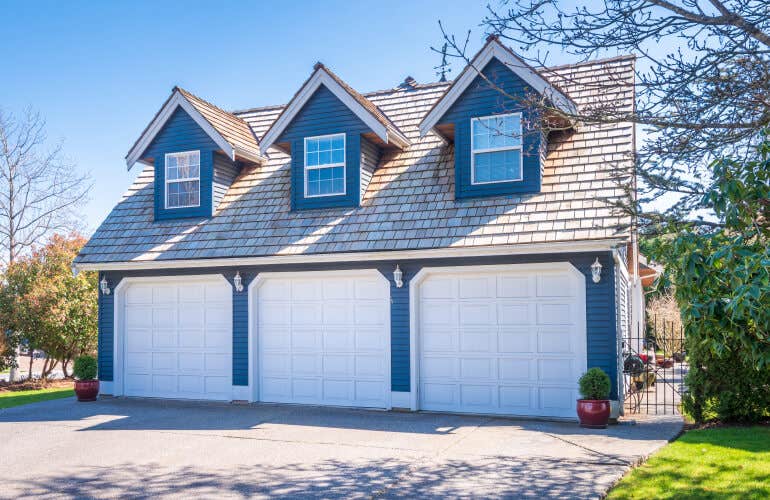Homeowners insurance made for you*
Protect the home you love. Get a free online quote in minutes.
What is home insurance & how does it work?
Home insurance is an essential financial tool that protects the largest investment most people make — their homes. A home insurance policy defends against financial losses when your home is damaged by certain perils. If a covered peril damages your home, you can file a claim with your insurance company to help pay for repairs.
In exchange for this financial protection, you make regular payments called premiums to the insurance company every month, quarter, six months, or year, depending on the details of your policy. There are many different types of home insurance, and most policies can be customized to cover what matters most to you.
What does home insurance cover?
A standard homeowners insurance policy has six distinct parts. Each addresses a particular risk that may cause you a financial loss as a homeowner.
Dwelling coverage (Coverage A) is for the structure of your primary residence. When it's damaged by covered perils, your policy pays for repair and replacement costs, minus your deductible and up to the coverage limit.
Other structures coverage (Coverage B) is for additional buildings on your property, like sheds and detached garages, as well as structures like inground pools, walkways, and permanently installed boat docks.
Personal property coverage (Coverage C) compensates you when the contents of your home are damaged by covered perils, such as furnishings, electronics, clothing, jewelry, collectibles, bedding, or tools.
Personal liability coverage (Coverage D) protects against financial loss stemming from an accident in or outside of your home that caused bodily injuries or property damage to someone else. It can cover medical bills, legal fees, and other costs you are legally responsible for.
Loss of use coverage (Coverage E) provides valuable additional protection if your home becomes temporarily uninhabitable due to damage caused by a covered peril. It helps pay for living expenses that go beyond your normal costs while your home is being repaired, like a hotel room or rental home, additional commuting costs, and food bills.
Medical payment coverage (Coverage F) is similar to personal liability insurance because it kicks in when someone who isn’t insured by your policy is injured at your home. Even if the accident is that person’s fault, your coverage can help with their medical bills.
Related Posts:Get More Answers
Displaying post 1 / 6
What's Covered?
- Covered,Fire / smoke damage
- Covered,Hurricanes
- Covered,Hail
- Covered,Lightning
- Covered,Theft
- Covered,Water damage from burst pipes and appliance flooding
- Covered,Vandalism
- Covered,Water overflow
- Covered,Civil unrest
- Covered,Explosions
- Covered,Falling objects
- Covered,Power surges
- Covered,Freezing of household systems
- Covered,Damage caused by vehicles
- Covered,And more
What’s Not?
- Not Covered,Earthquakes
- Not Covered,Flood
- Not Covered,General wear and tear
- Not Covered,Negligence (or lack of regular and proper maintenance)
- Not Covered,Business liability
How much home insurance do you need?
You’re usually required to have home insurance if you have a mortgage, and you should have enough to cover the costs to fully rebuild your home, plus an additional 60%. The additional percentage covers the rebuilding costs for each of the following three coverage areas:
-
Personal property
-
Additional living expenses / loss of use
-
Liability insurance
The cost to rebuild your home is calculated roughly by the square footage of your home multiplied by building costs per square foot in your area.
For your belongings, other structures, and additional living expenses, the general rule is to have at least 20% of your dwelling insurance. So if your home is insured for $300,000, you’d want about $60,000 for each.
If you have high-value belongings and fixtures, it might make sense to increase that coverage to 50% of your dwelling. You may also want to look at our Signature Coverage Collection to boost your protection.
What coverage level do you need?
Not all insurance policies are created equal. Your policy can pay for claims differently depending on the coverage level you choose.
Actual cash value coverage. This type of policy only pays the depreciated value of your home or lost belongings. In other words, it only pays for what they’re worth at the time of the loss, not what you paid for them or what it really costs to replace them.
Replacement cost coverage. This pays for what it actually costs to rebuild your home or replace your belongings. Unlike actual cash value, this provides payment to replace what’s damaged or stolen.
Additional Coverage A. Also called guaranteed, increased or extended replacement cost coverage, this is an inflation buffer in case building and repair costs soar when you need to make a claim. For example, with Kin, this provides more coverage than you purchased, extending your dwelling coverage limits by up to 25%. Another option is to get our Signature Collection Coverage which offers even more coverage.
All the policies we sell are offered on a replacement cost basis. That’s because we want you to be able to bring your home back to its original glory when you need to. It’s one less thing to worry about when you’re dealing with a major loss.
Choosing your
coverage limit
| Type of coverage | Standard limits |
|---|---|
| Dwelling | Home's full replacement cost |
| Other structures | 10% of dwelling amount |
| Personal property | 50% of dwelling amount |
| Loss of use | 20% of dwelling amount |
| Personal liability | $300,000 minimum |
| Medical payments | $1,000 minimum |
How much does home insurance cost?
Homeowners in the U.S. pay an average of $1,411 per year for their home insurance according to the most recent data from the Insurance Information Institute (III) and the National Association of Insurance Commissioners (NAIC).
However, the average cost of home insurance varies from state to state, since each state has its own rules, regulations, and risks.
What factors affect home insurance rates?
Several factors impact the cost of your home insurance premium.
Age. The year of your home’s construction affects rates mainly because of changing building codes for major systems, like electrical and plumbing. The assumption is that updated building codes are based on newer technologies, making new homes more resilient.
Location. At the local level, rates can be impacted by how close the home is to fire protection or if it’s in a higher crime area. Your home’s proximity to a coastline or wildfire zone may also play a role. At the state level, insurance laws and regulations are a factor, as well as any geography that makes your state more susceptible to severe weather conditions like hurricanes or tornadoes.
Building materials. Whether your home is primarily made up of brick, stone, wood, concrete, or cinder block influences its resilience to some perils. Construction materials also impact your replacement cost, which is a major factor in your overall premium.
Size. Because the structure of your home is typically insured for its overall replacement cost, its square footage has a big impact on your homeowners insurance rate. The larger your home is, the more expensive it is to replace, and so it requires more coverage.
Coverage amount. When you need more insurance, you pay a higher premium. So if you have a really large house or lots of valuable personal property, you’ll typically have to pay more to insure it. The same is true for endorsements and riders. Anything that increases your coverage will cause an increase in your overall home insurance policy premiums.
Deductible amount. A home insurance deductible is the out-of-pocket expense you’re responsible for when you have a claim. As it goes up, your premium usually goes down.
Credit history. Insurance providers in some states can use a credit-based insurance score when determining premiums. In those places, homeowners who have good credit often see lower rates.
Insurance claims history. While you absolutely should file a claim when you have damage, you want to keep in mind your claims history plays a role in your premium. The claims you file, as well as claims made on your property by previous owners, stay on your record for up to seven years. Multiple claims may result in a higher premium. That said, insurers don’t necessarily look at your entire history. Some may only check the past three years.
Your insurance company. Every insurer has its own method for analyzing data and determining rates. As a result, premiums can vary significantly from one insurance company to another. That’s why we typically recommend comparing multiple quotes when shopping for home insurance.
How to get homeowners insurance quotes
It's a best practice to get quotes from at least three different providers so you can compare offers. Most home insurance providers will now allow you to get quotes through their website, or at least over the phone, instead of having to visit an in-person office. The process is usually fast and easy, but it helps to have the following information on-hand:
- Your home address
- The names of everyone who will live in the house and your relation to them
- How many pets (and if dogs, what breed)
- The year your house was built and the age of your roof
- The materials used to construct your roof
- The materials used to construct your foundation
- How the home is heated
How to choose the right home insurance policy
Cheap home insurance may be great when you buy the policy, but it won’t do you much good if you end up being underinsured. You need to also look at the coverage, deductibles, and potential discounts.
Learn the difference between actual cash value and replacement cost value. One important aspect of a home insurance policy is whether claims are paid based on your property’s replacement cost value or actual cash value. The standard is to insure your dwelling and other structures for their replacement cost and your personal property for its actual cash value. However, not every policy is written this way, so you could conceivably be comparing a more expensive RCV policy that provides broader coverage to a less expensive, but also more limited, ACV policy.
Decide between named perils or open perils coverage. HO-3 polices are the most common type of home insurance, and they’re written as open perils coverage. This means they include all perils except those listed as exclusions. Other policies may be written as named perils coverage that only covers perils listed in the policy. Open peril policies provide more coverage, so they cost more.
Understand the role of deductibles. Because the size of your deductible impacts your premium (i.e., a lower deductible means a higher rate), you want to make sure you’re looking at similar deductibles when you compare quotes. You also want to check how many deductibles each policy has. Depending on where you live and what insurer you use, you may find your home insurance has an AOP deductible, a hurricane deductible, or a wind/hail deductible. Policies can have any combination of these deductibles, so you need to check what’s included in the quotes as you compare.
Frequently asked questions about home insurance
Am I legally required to carry homeowners insurance?
No state currently has any law that mandates homeowners to get insurance. However, your lender or mortgage company may require coverage as part of your loan agreement. In other words, your home insurance may not be legally required, but it could still be mandatory.
If I own my home outright, can I go with minimal or no home insurance?
Those without loans against their homes may choose to self-insure or "go bare." This is a risky situation, especially if the homeowner doesn't have the financial resources to repair or replace their homes following a disaster.
What happens if I allow my homeowners insurance to expire?
If your homeowners insurance lapses while you have a loan, your lender can get force-placed coverage for your property to protect its financial interests. This type of homeowners insurance can be very limited and extremely expensive.
What are valuable characteristics to look for when choosing a home insurance provider?
You want an insurance company that has exceptional financial ratings so you’ll know that it’s capable of meeting its obligations. A good reputation with customers is important, too, so check online review sites like Trustpilot and the Better Business Bureau.
Check out how much our customers love Kin
The opinions expressed belong solely to individual reviewers and do not reflect the opinions of the Kin Insurance, Inc. group of companies or affiliates. Reviews are provided for informational purposes only.
Related Posts:Keep exploring
Displaying post 1 / 3






